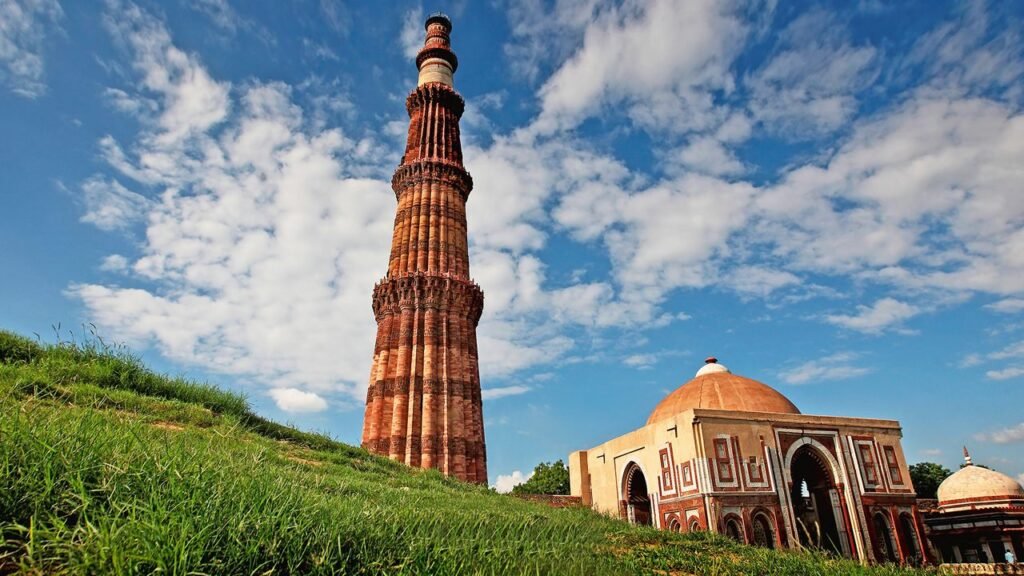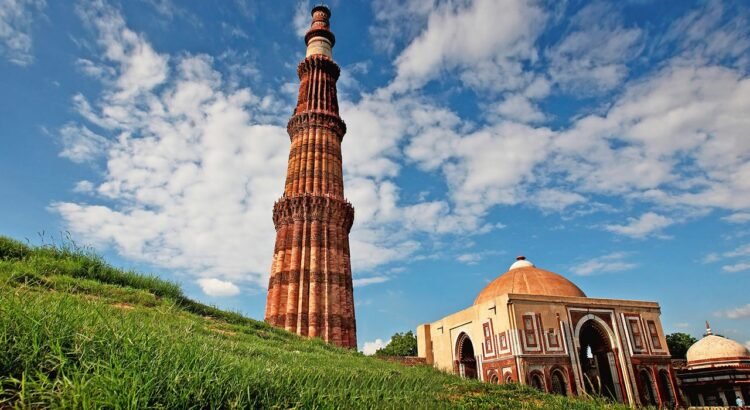
Towering over the historic heart of Delhi, India, the Qutub Minar stands as a soaring testament to the architectural brilliance and layered history of the Indian subcontinent. At 73 meters tall, this intricately carved minaret is not just the tallest brick minaret in the world but also a symbolic structure that marks the beginning of Islamic rule in India. Declared a UNESCO World Heritage Site, Qutub Minar has captivated historians, architects, artists, and travelers for centuries — and continues to draw thousands each year into its magnificent shadow.
From the red sandstone base to the elegant fluted shaft decorated with Arabic calligraphy, the Qutub Minar is not merely a relic from the past; it is a living monument that tells the story of dynasties, religion, and cultural fusion. To stand before it is to gaze up at nearly 1,000 years of history etched into stone.
A Tower Born of Victory
The construction of Qutub Minar began in 1192 CE, commissioned by Qutb-ud-din Aibak, the first ruler of the Delhi Sultanate. The tower was intended to celebrate Muslim dominance in Delhi following the defeat of the last Hindu kingdom in the region. It also served a religious purpose: functioning as a minaret for the adjacent Quwwat-ul-Islam Mosque, the first mosque built in Delhi, from where the muezzin would call the faithful to prayer.
Aibak completed only the base of the tower; it was his successor and son-in-law, Iltutmish, who added three more stories around 1220. The tower was later damaged by lightning and earthquakes, prompting several restorations, most notably under Firoz Shah Tughlaq in the 14th century and Sikandar Lodi in the 16th.
Despite these restorations and repairs, Qutub Minar has retained its original grandeur — a testament to the architectural resilience and vision of its creators.
Architectural Grandeur in Red and Sandstone
Qutub Minar is a masterpiece of Indo-Islamic architecture, blending Afghan design with local Indian influences. Made primarily of red sandstone, with sections of white marble added during later renovations, the tower rises in five distinct stories, each marked by a projecting balcony supported by intricately decorated brackets.
The first three stories are constructed of red sandstone; the fourth and fifth — added by Firoz Shah Tughlaq — incorporate white marble and sandstone, creating a striking visual contrast.
What truly sets Qutub Minar apart are its carvings. The surface of the minaret is adorned with intricate Arabic inscriptions, including verses from the Quran, as well as floral and geometric motifs that reflect both Islamic and Indian artistic traditions. These carvings not only showcase the craftsmanship of artisans but also provide valuable historical records.
A Vertical Chronicle of Dynasties and Earthquakes
The Qutub Minar is more than a beautiful structure; it is a vertical timeline. Each section of the tower reflects the aesthetic and political priorities of the ruler who contributed to it:
- Qutb-ud-din Aibak’s base is massive and solid, embodying the first efforts of a new dynasty to assert dominance.
- Iltutmish’s additions are more refined, with increased use of decorative elements.
- Firoz Shah Tughlaq’s upper stories are marked by lighter materials and Islamic calligraphy that showcases the era’s matured architectural flair.
The tower has survived numerous natural calamities. Earthquakes in the 14th and 16th centuries caused serious damage, but each time it was restored — often with new stylistic additions, making it a palimpsest of evolving design over time.
Quwwat-ul-Islam Mosque: The Power of Faith
Adjacent to the Qutub Minar is the Quwwat-ul-Islam Mosque (meaning “Might of Islam”), built from materials recycled from 27 Hindu and Jain temples. Its pillared halls, adorned with Hindu-style carvings, contrast sharply with Islamic arches and calligraphy, reflecting the complex interplay of conquest and culture.
This mosque, completed in 1198, is one of the earliest examples of Indo-Islamic architecture and stands as an essential part of the Qutub Complex.
The Iron Pillar: A Metallurgical Marvel
Another intriguing structure within the Qutub complex is the Iron Pillar of Delhi, believed to have been erected in the 4th century during the reign of Chandragupta II of the Gupta Empire — long before the Qutub Minar. The pillar stands approximately 7 meters tall and weighs over 6 tons.
What astonishes scientists and historians alike is the pillar’s remarkable resistance to corrosion despite being exposed to Delhi’s climate for over 1,600 years. Its presence in the Qutub complex is a symbol of India’s ancient scientific prowess and its coexistence with Islamic architecture underscores the region’s layered history.
The Alai Minar: A Tower That Never Was
A short distance from the Qutub Minar stands the Alai Minar, an unfinished tower envisioned by Alauddin Khilji, who ruled Delhi in the early 14th century. He planned to build a minaret twice as tall as Qutub Minar to reflect his imperial ambitions. However, only the first storey — about 25 meters — was ever completed before his death.
The Alai Minar serves as a monument to unfulfilled dreams, standing in stark contrast to the completed elegance of the Qutub Minar.
UNESCO World Heritage Status and Conservation
In 1993, the Qutub Minar Complex was inscribed as a UNESCO World Heritage Site in recognition of its architectural and cultural significance. It is protected and managed by the Archaeological Survey of India (ASI), which has overseen various conservation efforts to preserve its structure and heritage.
Ongoing conservation work includes structural stabilization, cleaning of carvings, and preservation of ancient inscriptions. These efforts aim to ensure that the site continues to inspire future generations without losing its original character.
The Qutub Complex Today: A Cultural Beacon
Today, the Qutub Complex is not only a historic site but also a center for cultural exploration. Travelers from all over the world visit to admire the artistry of the minaret, delve into Delhi’s layered past, and experience the spiritual silence that often descends upon the grounds, especially during early mornings and sunset hours.
The complex is also used for light and sound shows, heritage walks, and occasionally for state functions and cultural events. During the Qutub Festival, classical music and dance performances take place under the shadow of the towering minaret, bringing a modern pulse to ancient stones.
Practical Visitor Information
- Location: Mehrauli, South Delhi, easily accessible by Metro (Qutub Minar station)
- Opening Hours: Sunrise to Sunset, every day
- Entry Fee: Approx. ₹40 for Indian citizens and ₹600 for foreign nationals
- Best Time to Visit: October to March (cooler months)
- Pro Tip: Arrive early to avoid crowds and capture the golden morning light on the minaret.
Symbolism and Legacy
The Qutub Minar is more than an architectural icon. It stands as a symbol of conquest, continuity, and cultural fusion. It embodies the ambition of rulers, the genius of artisans, and the resilience of history.
For Indian citizens, it is a national heritage emblem — frequently featured in textbooks, tourism campaigns, and currency. For global travelers, it is a gateway into India’s medieval Islamic period, offering a glimpse of how diverse cultures left their mark on the subcontinent.
Conclusion: A Pillar of Timeless Majesty
To visit the Qutub Minar is to stand before a monument of ambition and artistry, to read a history carved in stone, and to marvel at the confluence of faith, culture, and power. From the decorative Quranic verses spiraling up its shaft to the whisper of the wind through its balconies, every detail invites reflection.
Whether you’re a lover of architecture, a student of history, or a seeker of beauty, the Qutub Minar offers a journey not just through space, but through time — reminding us that even in the rise and fall of empires, human creativity leaves behind echoes that continue to inspire.




